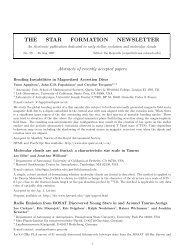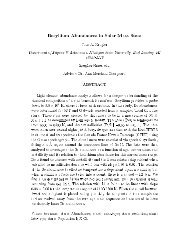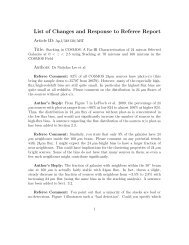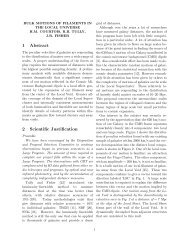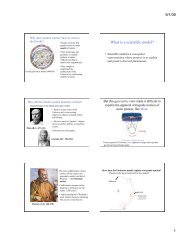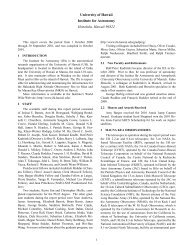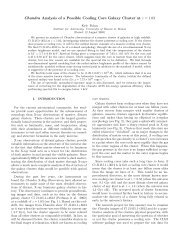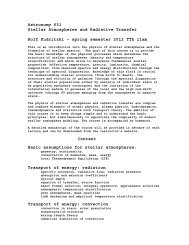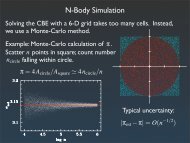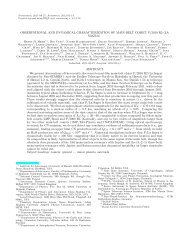lecture slides
lecture slides
lecture slides
Create successful ePaper yourself
Turn your PDF publications into a flip-book with our unique Google optimized e-Paper software.
Astronomy 110: SURVEY OF ASTRONOMY<br />
13. THE REALM OF THE NEBULAE<br />
1. Distances and Types of Galaxies<br />
2. Hubble’s Law and Galaxy Evolution<br />
3. Peculiar and Active Galaxies
Galaxy History Revealed in This Colorful Hubble View
1. DISTANCES AND TYPES OF GALAXIES<br />
a. An Extragalactic Distance Scale<br />
b. Galaxy Morphology<br />
c. Groups and Clusters
Parallax Distances<br />
Nearby stars appear<br />
to shift back and forth<br />
as we orbit the Sun.<br />
Dec<br />
2p<br />
June<br />
The parallax angle p is<br />
inversely proportional to<br />
D<br />
the distance D:<br />
D <br />
1<br />
2π<br />
360° AU<br />
p<br />
p<br />
AU<br />
Using parallax, we can measure stellar distances out to<br />
a few hundred light-years.
Luminosity Distances<br />
The same luminosity L must<br />
pass through each sphere.<br />
A sphere of radius D has area<br />
A = 4πD 2<br />
So brightness is inversely<br />
proportional to (distance) 2 :<br />
B = L A<br />
L<br />
= 4πD 2<br />
D =<br />
√<br />
L<br />
4πB<br />
An star of known luminosity L is a standard candle.
Main Sequence Fitting<br />
All stars in a cluster<br />
have the same distance,<br />
so plot HR diagrams<br />
for clusters using<br />
apparent brightness.<br />
MS in Hyades appears<br />
7.5 times brighter than<br />
MS in Pleiades; why?<br />
Pleiades are √7.5 2.7 times further away than Hyades!
Distance Scale: Summary<br />
1. Parallax measurements within the solar system gave<br />
an accurate value for the astronomical unit:<br />
1 AU = 1.496×10 8 km<br />
2. Using the Earth’s orbit as a baseline, stellar parallax<br />
provides a distance to the Hyades cluster:<br />
DHyades = 9.56×10 6 AU = 151 ly<br />
3. Main sequence fitting yields the distance to other<br />
clusters in the galaxy in terms of DHyades.<br />
At each step, known distances are<br />
used to find unknown distances.
Cepheid Variable Stars<br />
Brightness (mag)<br />
3.5<br />
4.0<br />
4.5<br />
Period<br />
2 4 6 8 10 12<br />
Time (days)<br />
delta Cephei<br />
Massive stars become Cepheid Variables at one<br />
phase of their lives after leaving the main sequence.<br />
During this phase, they vary in size, temperature, and<br />
brightness in regular ways with well-defined periods.
Period-Luminosity Relationship. I<br />
Cepheids in the Large Magellanic Cloud<br />
were found to obey a relationship<br />
between period and apparent brightness.<br />
Large Magellanic Cloud<br />
100<br />
These stars are all at the<br />
same distance, so their<br />
apparent brightnesses are<br />
proportional to their<br />
absolute luminosities.<br />
relative apparent brightness<br />
absolute luminosity<br />
10<br />
1.0<br />
0.1<br />
0.01<br />
So Cepheids must obey a period-luminosity relationship!
Period-Luminosity Relationship. II<br />
To be useful for distance measurements, the P-L<br />
relationship must be calibrated in units of L by<br />
measuring absolute luminosities of some Cepheids.<br />
Cepheids in star clusters<br />
are handy for this, since<br />
distances are available via<br />
main-sequence fitting.<br />
Once this is done, a<br />
Cepheid’s luminosity can<br />
be found from its period.
The Distance to Andromeda (M31)<br />
Is M31 another galaxy, or part of the Milky Way?<br />
The luminosities of several Cepheids<br />
in M31 were determined from their<br />
periods via the P-L relationship.<br />
Andromeda Nebula: Var!<br />
Given their luminosities and brightnesses, distances to<br />
these Cepheids could be computed: DM31 2.4×10 6 ly.<br />
M31 is far beyond the Milky Way!<br />
M31: The Andromeda Galaxy
White Dwarf Supernovae: Standard Bombs<br />
These supernovae have a very narrow range of peak<br />
luminosities since they always occur in the same way.<br />
To calibrate this peak, we must observe supernovae in<br />
galaxies with distances known from Cepheid variables.
An Extragalactic Distance Scale<br />
10 -3 ly 1 ly 10 3 ly 10 6 ly 10 9 ly<br />
Interlocking methods allow distances up to ~10 10 ly to<br />
be measured fairly reliably.
Spiral Galaxy, Inclined<br />
M63: The Sunflower Galaxy
Spiral Galaxy, Edge-On<br />
NGC 4565: Needle Galaxy
Barred Spiral Galaxy<br />
NGC 1365: A Nearby Barred Spiral Galaxy
‘Grand Design’ Spiral Galaxy<br />
M51 Hubble Remix
Disk Galaxy With Large Bulge<br />
The Sombrero Galaxy from VLT
Lenticular Galaxy With Dust<br />
NGC 2787: A Barred Lenticular Galaxy
Giant Elliptical Galaxy With Companions<br />
Galaxies Away
Dwarf Elliptical Galaxy<br />
Companions to M31<br />
M32: Blue Stars in an Elliptical Galaxy<br />
M31: The Andromeda Galaxy
Irregular Galaxy (Large Magellanic Cloud)<br />
The Large Cloud of Magellan
Peculiar Galaxy<br />
The Colliding Galaxies of NGC 520
Hubble’s Galaxy<br />
Classification<br />
Irregular and peculiar<br />
galaxies not included.<br />
The Hubble Tuning Fork — Classification of Galaxies
The Local Group: Over 30 Galaxies<br />
two large spirals<br />
with satellites<br />
one smaller<br />
spiral<br />
many dwarf elliptical and irregular galaxies<br />
Local Group
The Virgo Cluster: : Over 1000 Galaxies!<br />
Distance: ~6 × 10 7 ly<br />
three massive elliptical galaxies<br />
many MW-sized galaxies<br />
M86 in the Virgo Cluster
A Rich Regular Galaxy Cluster<br />
Distance: ~2.5 × 10 8 ly<br />
mostly elliptical galaxies<br />
Galaxies of the Perseus Cluster
A Rich Irregular Galaxy Cluster<br />
Distance: ~5 × 10 8 ly<br />
many disk galaxies<br />
some are colliding<br />
The Hercules Cluster of Galaxies
A Compact Group<br />
Distance: ~6 × 10 7 ly<br />
one elliptical galaxy<br />
three spiral galaxies<br />
Galaxy Group Hickson 44
2. HUBBLE’S LAW AND GALAXY EVOLUTION<br />
a. The Expanding Universe<br />
b. Looking Back in Time<br />
c. Class Survey
The Doppler Shift<br />
Doppler Effect<br />
Doppler Effect<br />
A stationary source sends<br />
out waves of the same<br />
wavelength in all<br />
directions.<br />
If the source is moving,<br />
the waves bunch up<br />
ahead of its motion, and<br />
spread out behind.
The Doppler Shift: Light<br />
We get a similar effect<br />
with light. The change in<br />
wavelength λ depends on<br />
the source’s velocity v<br />
toward or away from us:<br />
red-shift<br />
blue-shift<br />
λshift - λrest<br />
λrest<br />
= v c<br />
Note: valid for v c<br />
where λshift is the observed (shifted) wavelength, λrest is<br />
the wavelength with the source at rest, and c is the<br />
speed of light.
The Redshift<br />
Text<br />
Most galaxies have spectra systematically shifted toward<br />
the red, implying that they’re moving away from us.
The Redshift: An Example<br />
Define the redshift:<br />
λshift - λrest<br />
λrest<br />
= z<br />
line<br />
λrest<br />
(nm)<br />
λshift<br />
(nm)<br />
z<br />
v = c z<br />
(km/s)<br />
Hβ 486.1 500.9 0.0304 9120<br />
Hγ 434.1 447.3 0.0304 9120<br />
Hδ 410.2 422.7 0.0304 9120<br />
Arp 188 and the Tadpole's Tidal Tail
The Expansion of the Universe<br />
Plotting galaxy velocities,<br />
v, against their distances,<br />
d, revealed a relationship:<br />
v H0 d,<br />
where H0 is Hubble’s<br />
“constant”:
The Expansion of the Universe<br />
Plotting galaxy velocities,<br />
v, against their distances,<br />
d, revealed a relationship:<br />
v H0 d,<br />
where H0 is Hubble’s<br />
“constant”:<br />
H0 22 km/s/Mly.<br />
Two consequences:<br />
(1) galaxy redshifts can be used to estimate distances;<br />
(2) the universe is expanding.
The Cartoon History of the Universe
The Universe Has No Center!<br />
Observed from Galaxy A<br />
Observed from MW<br />
Observed from Galaxy B<br />
MW<br />
MW<br />
MW<br />
A<br />
B<br />
A<br />
B<br />
A<br />
B<br />
All observers see other galaxies moving away from their<br />
position with speeds proportional to distances.<br />
The expansion does not define a center!
The Universe Has No Center!<br />
The universe shows no sign<br />
of edges — it seems to be<br />
infinite in all directions.<br />
Cosmological Principle:<br />
The universe looks<br />
roughly the same<br />
everywhere.<br />
• Matter is evenly distributed on very large scales.<br />
• There is no center and no edges.<br />
• Not proved but consistent with observations.
The Universe Has An Age!<br />
Assume that galaxies move apart at constant speeds;<br />
how long ago were they all ‘on top of each other’?<br />
A galaxy at distance d = 1000 Mly moves away at speed<br />
v = H0 d = (22 km/s/Mly) × 1000 Mly = 22000 km/s<br />
The time required to travel this distance is<br />
d<br />
v =<br />
1000 Mly<br />
22000 km/s = 9.5×1021 km<br />
22000 km/s = 4.32×1017 s = 13.7 Gyr<br />
(Note: d cancels out; you get the same time for any d!)<br />
13.7 Gyr is a good estimate for the Universe’s age!
High Redshift<br />
Redshifts z bigger than<br />
one can’t be interpreted<br />
dtoday<br />
in terms of galaxy velocity:<br />
v = c z<br />
A correct interpretation:<br />
dtoday<br />
1 + z = d then<br />
then<br />
dthen<br />
Example: from redshift<br />
z = 2 to today, galaxy<br />
distances have tripled.<br />
galaxy<br />
location<br />
then
Looking Back in Time<br />
Light travels at finite speed, so when we look out into<br />
space we are also looking back in time!<br />
Many of these galaxies are billions of lightyears away, so<br />
we’re seeing them as they were billions of years ago.<br />
Galaxy History Revealed in This Colorful Hubble View
Lookback Time<br />
Lookback time is related<br />
to redshift: longer times<br />
correspond to higher<br />
redshifts.<br />
z<br />
tback (Gyr)<br />
then<br />
1 7.73<br />
2 10.3<br />
3 11.5<br />
∞ 13.7<br />
galaxy<br />
location<br />
then
z ≈ 2
High-Redshift Galaxies<br />
200-million-year-old baby galaxies<br />
200-million-year-old baby galaxies<br />
These galaxies have redshifts z ≈ 7 to 7.5, implying<br />
lookback times of ~ 13 Gyr; back then, the age of the<br />
universe was only 700 Myr.
High-Redshift Galaxies<br />
200-million-year-old baby galaxies<br />
200-million-year-old baby galaxies<br />
• Irregular shapes; no apparent symmetry<br />
• Very high rates of star formation<br />
• Powerful outflows of gas
1. What do we need to know about a star before we<br />
can use it as a standard candle?<br />
A. Mass<br />
B. Diameter<br />
C. Age<br />
D. Luminosity<br />
E. Temperature
2. We compute the peak luminosity of a white-dwarf<br />
supernovae in another galaxy by determining its<br />
distance using __________ and measuring its<br />
__________.<br />
A. parallax; temperature from spectra<br />
B. Cepheids in the same galaxy; apparent brightness<br />
C. main-sequence fitting; apparent brightness<br />
D. Cepheids in the same galaxy; makeup from spectra<br />
E. parallax; mass using orbital motion
3. What kind of galaxy is this?<br />
A. Irregular<br />
B. Elliptical<br />
C. Barred spiral<br />
D. Regular spiral<br />
E. High-Redshift<br />
NGC 1365
4. Where do we see evidence of recent star formation?<br />
D<br />
A<br />
B<br />
C<br />
E<br />
NGC 1365
5. Which of these is an elliptical galaxy?<br />
A<br />
D<br />
E<br />
B<br />
C<br />
M86 in the Virgo Cluster
6. How can we tell another galaxy is moving away?<br />
A. It appears smaller from year to year.<br />
B. It appears fainter from year to year.<br />
C. Its spectral lines are shifted toward the blue.<br />
D. Its spectral lines are shifted toward the red.<br />
E. Its parallax angle gets smaller over time.
7. If galaxy A has redshift zA = 0.05 and galaxy B has<br />
redshift zB = 0.1,<br />
A. galaxy A is twice as far as galaxy B.<br />
B. both galaxies have the same distance.<br />
C. galaxy B is twice as far as galaxy A.<br />
D. galaxy B is four times as far as galaxy A.<br />
E. we cannot tell which galaxy is further.
8. Which statement is most likely to be correct?<br />
A. Other galaxies are moving away from the Milky<br />
Way, but not from each other.<br />
B. Every galaxy in the universe is surrounded by other<br />
galaxies which are moving away from it.<br />
C. The universe is a finite sphere of galaxies expanding<br />
into empty space.<br />
D. All galaxies are orbiting the center of the universe.<br />
E. Galaxies are moving away from the Milky Way with<br />
speeds which do not depend on their distances.
3. PECULIAR AND ACTIVE GALAXIES<br />
a. Galaxy Collisions<br />
b. Starburst Galaxies<br />
c. Active Galaxies
e 1.4 Galaxy sample in this study. Top and middle row from left to right: Arp<br />
7469, NGC 4676 and Arp 299. Bottom row from left to right: IC 883, NGC 2623<br />
Interacting and Merging Galaxies<br />
Figure 1.4 Galaxy sample in this study. Top and middle row fro<br />
NGC 7469, NGC 4676 and Arp 299. Bottom row from left to right<br />
NGC 7252. North is up, and east is to the left. Most colored image<br />
ACS/WFC images (courtesy of NASA, the Hubble Heritage, A. Ev<br />
http://hubblesite.org/newscenter/archive/releases/galaxy/interac<br />
and courtesy of NASA, H. Ford, G. Illingworth, M. Clampin, G. Ha<br />
Team, taken from http://hubblesite.org/newscenter/archive/relea<br />
Image of NGC 7252 is restored from B- and R-band images taken<br />
from Hibbard et al. (1994).<br />
Some galaxies don’t fit the elliptical/spiral/irregular classification.<br />
Figure 1.4 Galaxy sample in this st<br />
12
How Can Galaxies Collide?<br />
If galaxies move away from each other as the universe<br />
expands, how can they ever collide?<br />
Interacting Galaxy UGC 9618<br />
The gravitational attraction of two massive galaxy halos<br />
can locally reverse the expansion and cause a collision.<br />
Most interacting pairs probably fell together “recently”.
Tides between disk galaxies create filaments of stars.<br />
SPIN<br />
–0.5<br />
0<br />
0.5<br />
1<br />
1.5<br />
2<br />
2.5<br />
3<br />
Galactic Bridges and Tails
A Simulated Interaction
A Simulated Interaction<br />
Tidal Interaction
The Whirlpool Nebula<br />
M51 Hubble Remix
The Mice: Two Colliding Spirals<br />
"The Mice": Colliding Galaxies<br />
NGC 4676: True-Color RGB Image
Simulation of the Mice<br />
The Mice at Play
Why do Galaxies Merge?<br />
Tidal forces transform the organized orbital motion of<br />
galaxies into random motions of stars and dark matter.<br />
• This is a form of friction — it slows galaxies down.<br />
• Dark matter plays critical role — absorbs momentum.
What Kind of Galaxy is Produced?<br />
Random stellar orbits can naturally account for the oval<br />
shapes and slow rotation of elliptical galaxies.<br />
• Merger hypothesis: spiral galaxies merge to form<br />
elliptical galaxies.<br />
• Estimated merger rates can produce right number of<br />
elliptical galaxies.<br />
• Need additional star formation in mergers to form<br />
cores of elliptical galaxies.
The Antennae<br />
Super Star Clusters in the Antennae Galaxies<br />
Rapid star formation is common<br />
NGC 4038/4039<br />
in merging spiral galaxies!
Antennae Simulation With Star Formation
Starburst Galaxies<br />
Galaxy Wars: M81 versus M82
Starburst Galaxies<br />
Starburst Galaxy M82<br />
Star formation rate:<br />
~10 × Milky Way’s.<br />
Gas outflow driven<br />
by supernovae<br />
Galaxy Wars: M81 versus M82
Arp 299: Supernova Factory<br />
First encounter<br />
~700 Mry ago<br />
Ultra-Luminous<br />
Infrared Galaxy<br />
(L > 10 12 L )<br />
Interacting Galaxy NGC 3690
Arp 220: Merger Remnant<br />
Core contains as much<br />
gas as entire Milky Way!<br />
A Collision In The Heart Of A Galaxy<br />
Star formation rate:<br />
~100 × Milky Way’s!<br />
Active nucleus<br />
as well as stars.<br />
Interacting Galaxy Arp 220
If the center of a<br />
galaxy is<br />
unusually bright,<br />
we call it an<br />
active galactic<br />
nucleus.<br />
Quasars are the<br />
most luminous<br />
examples.<br />
Active Nucleus in M87<br />
Copyright © 2009 Pearson Education, Inc.
Galaxies<br />
around<br />
quasars<br />
sometimes<br />
appear<br />
disturbed by<br />
collisions.<br />
Copyright © 2009 Pearson Education, Inc.
Radio galaxies contain active nuclei shooting out vast jets of<br />
plasma that emit radio waves coming from electrons moving at<br />
near light speed.<br />
Copyright © 2009 Pearson Education, Inc.
Characteristics of Active Galaxies<br />
• Luminosity can be enormous (>10 12 L Sun ).<br />
• Luminosity can rapidly vary (comes from a space<br />
smaller than solar system).<br />
• They emit energy over a wide range of wavelengths<br />
(contain matter with wide temperature range).<br />
• Some drive jets of plasma at near light speed.<br />
Copyright © 2009 Pearson Education, Inc.
What is the power source for quasars<br />
and other active galactic nuclei?<br />
Copyright © 2009 Pearson Education, Inc.
The accretion of gas onto a supermassive black hole appears to<br />
be the only way to explain all the properties of quasars.<br />
Copyright © 2009 Pearson Education, Inc.
Energy from a Black Hole<br />
• The gravitational potential energy of matter falling<br />
into a black hole turns into kinetic energy.<br />
• Friction in the accretion disk turns kinetic energy<br />
into thermal energy (heat).<br />
• Heat produces thermal radiation (photons).<br />
• This process can convert 10–40% of E = mc 2 into<br />
radiation.<br />
Copyright © 2009 Pearson Education, Inc.
Jets are thought to come from the twisting of a magnetic field<br />
in the inner part of the accretion disk.<br />
Copyright © 2009 Pearson Education, Inc.
Copyright © 2009 Pearson Education, Inc.<br />
Do supermassive black holes<br />
really exist?
Orbital speed and distance of gas orbiting center of M87<br />
indicate a black hole with mass of 3 billion M Sun .<br />
Copyright © 2009 Pearson Education, Inc.
Orbits of stars<br />
at center of<br />
Milky Way<br />
indicate a black<br />
hole with mass<br />
of<br />
4 million M Sun .<br />
Copyright © 2009 Pearson Education, Inc.
Galaxies and Black Holes<br />
• The mass of a<br />
galaxy’s<br />
central black<br />
hole is closely<br />
related to the<br />
mass of its<br />
bulge.<br />
Copyright © 2009 Pearson Education, Inc.
Galaxies and Black Holes<br />
• The<br />
development<br />
of a central<br />
black hole<br />
must<br />
somehow be<br />
related to<br />
galaxy<br />
evolution.<br />
Copyright © 2009 Pearson Education, Inc.
Galaxy Mergers With Gas<br />
Transformations of Galaxies II: Gas Only<br />
Transformations of Galaxies II: Final Encounter
Mergers With Gas and Black Holes<br />
Galaxy Collisions Awaken Dormant Black Holes



